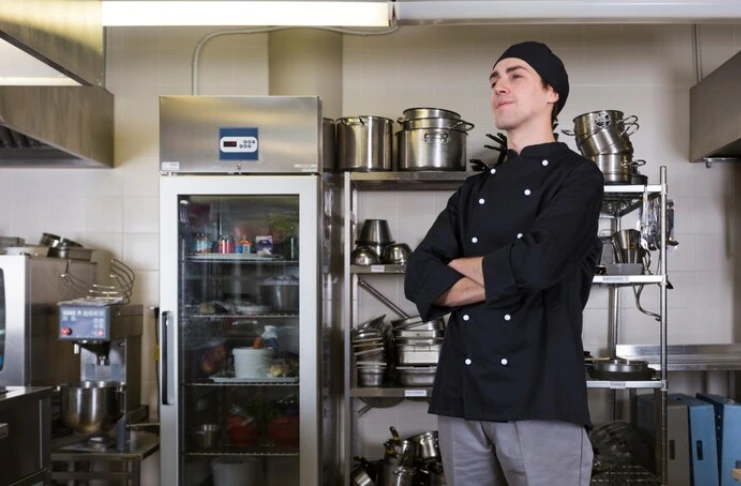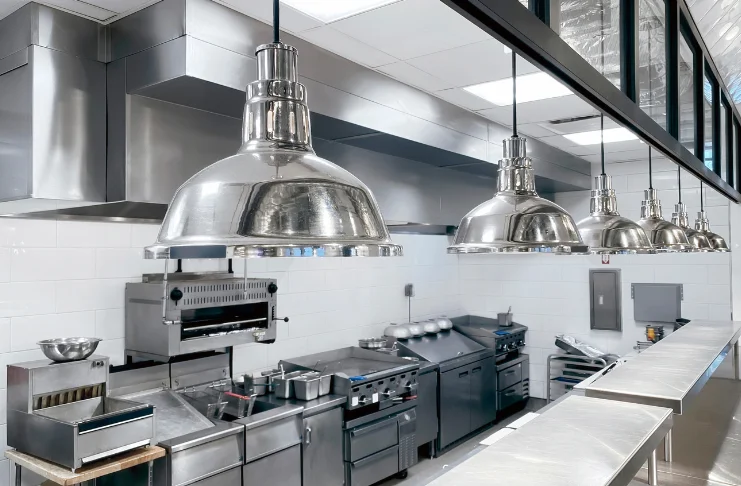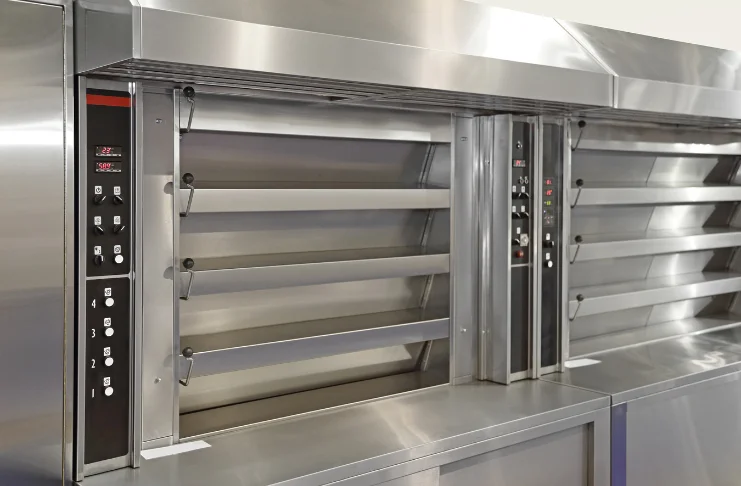
If you’re venturing into the world of cloud kitchens, you know how important the right equipment really is. In this blog, we’ll cover the most essential equipment needed for a cloud kitchen, how you should select the right tools, and share answers to common questions about cloud kitchens. Let’s get started!
What’s a cloud kitchen?
Before getting into the nitty-gritty of it all, let’s quickly understand what exactly a cloud kitchen or virtual kitchen is. It is a commercial kitchen space that functions solely to deliver ordered food online. There is no dine-in food service available in these kitchens, and they are only delivered.
The cloud Kitchen evolved with the growing online food delivery market. They are low-cost alternatives to traditional restaurants, through which an entrepreneur could start a food business without incurring the huge overhead costs associated with a physical dining space.
Why is equipment important for a cloud kitchen?

Efficiency and speed are the most integral parts that go into making a cloud kitchen. You can ensure efficient kitchen management with the right equipment, allowing you to prepare, cook, and package food quickly and efficiently while maintaining quality standards and safety measures.
Moreover, the right tools ensure reduced operational costs and increased productivity. Whether you’re providing food services as a business owner or operating virtual restaurants, adhering to local fire safety standards and carefully monitoring heat and temperature settings are essential for smooth and safe operations.
Proper equipment will also help you maintain consistency of quality within the food, which is an important factor when you have a constant stream of customers. Operational equipment of high quality and durability, such as an electric range and other cooking equipment, will not let you experience frequent breakdowns and equipment changing all the time. This disrupts operations and causes extra costs. In the restaurant business, having reliable tools, like mobile shelving units, is crucial, especially in dark kitchens where space and efficiency are key. Additionally, ensuring that your staff have employee health permits is essential for maintaining safety and compliance.
Essential cloud kitchen equipment
- Commercial Ovens
- Types: convection ovens, combi ovens, and conveyor ovens.
- Purpose: Baking, roasting, and cooking a wide variety of dishes.

Commercial ovens are the real backbone of cloud kitchens and one of the most important cooking equipment. Convection ovens are versatile and can do most of the jobs. Combi ovens combine steam and convection heat to allow flexibility for different cooking methods. Conveyor ovens are used for high-volume cooking where food is cooked on a conveyor belt that moves through the oven continuously.
- Stovetops and Ranges
- Types: gas, electric, induction.
- Purpose: cooking, boiling, and simmering.

The stovetop and range are the centerpieces of every kitchen. Alongside gas and electric ranges, gas fryers, electric fryers and commercial fryers are crucial for achieving precise cooking results. With gas ranges and gas fryer units, complete temperature control is possible, allowing for perfect frying conditions. Electric ranges and electric fryers offer ease of cleanup and require less maintenance. Induction cooktops complement these options by providing ultrafast and effective heating and are energy-efficient, making the kitchen more versatile and capable of handling various cooking tasks efficiently.
- Refrigeration Units
- Types: walk-in coolers, reach-in refrigerators, under-counter refrigerators
- Purpose: Storing perishable ingredients and prepared foods.

Adequate refrigeration, including produce refrigeration units, is important to maintain food safety and quality. Walk-in coolers have space for bulk storage of food items, while reach-in refrigerators make it easier to get what you need and are better for commonly used food. Under-counter refrigerators and specialized produce refrigeration units save space and keep key ingredients within your reach, ensuring that everything from fruits and vegetables to other perishables is kept at optimal temperatures.
- Freezers
- Types: chest freezers, upright freezers, blast freezers.
- Purpose: Storing frozen ingredients and products.
Refrigerators and freezers play a crucial role in ingredient longevity and meal preservation. Chest freezers offer more space and improved energy efficiency, whereas upright freezers offer better organization and access. Blast freezers will provide optimum conditions to rapidly freeze food that retains its texture and quality.
- Food Processors
- Types: blenders, mixers, slicers, and dicers, spice grinders, countertop mixers.
- Purpose: Fast preparation of ingredients.

Food processors save you time and labor by automating any repetitive task. Blenders are important for soups, sauces, and smoothies. Mixers are important for baking and the preparation of the dough. Slicers and dicers can easily replace the hectic task of cutting vegetables, fruits, and meats.
- Storage Solutions
- Types: shelving units, bins, and racks.
- Purpose: organizing ingredients, kitchen utensils, and equipment.
Efficient food storage solutions, including food storage containers, are needed to keep your kitchen organized and clutter-free and store raw materials. Shelving units maximize vertical space while allowing easy access to supplies. Bins, racks, and food storage containers help in categorizing and storing ingredients, which reduces the time spent searching for items. These solutions ensure that everything is well-organized, making your kitchen operations more streamlined and efficient.
- Prep tables and workstations
- Types: steel tables, butcher blocks.
- Purpose: Provide a clean and efficient space for food preparation.

Prep tables and workstations are the heart of every kitchen. Stainless steel tables and stainless steel counters offer strength, ease of cleaning, and bacteria resistance. Butcher blocks provide a solid surface for chopping and cutting. These durable surfaces ensure that kitchen operations can proceed with hygiene and efficiency, making them indispensable in any culinary setting.
- Dishwashing Unit Equipment
- Types: commercial dishwashers, sinks, drying racks
- Purpose: Hygiene and cleanliness of kitchen tools and utensils.

Cleanliness is of paramount importance to food safety. Commercial dishwashers process large volumes of dishes extremely quickly. Sinks for hand washing, rinsing, and sanitizing utensils are necessary, including a triple sink wash station which is essential for a thorough cleaning process. Drying racks secure utensils and dishes in a position that facilitates orderly drying, complementing the triple sink wash station to ensure all kitchen items are sanitized effectively.
- Cooking Utensils and Smallwares
- Types: knives, spatulas, pots, and pans
- Purpose: To assist with the food prep and cooking processes.

A properly set-up kitchen needs to have its share of cooking utensils and small wares. Good knives will come in handy for keen cutting and chopping; spatulas, ladles, and tongs will help in the cooking and serving processes. Various pots and pans will be needed for the different methods of cooking.
- Packaging Supplies
- Types: containers, bags, and wraps
- Purpose: Safely package food for delivery.

Good packaging ensures that food is delivered to customers in good condition. Tight containers with lids will not spill or leak their contents. Bags and wraps keep the food warm or cold on their way to the customers. Eco-friendly packages attract environmentally conscious customers.
- Supplies for Safety and Sanitation
- Types: gloves, aprons, and sanitizers
- Purpose: keeping the food safe and the kitchen clean.

Safety and hygiene in the kitchen should not be compromised. Disposable gloves and aprons prevent cross-contamination. Sanitizers and cleaning chemicals disinfect surfaces and equipment.
How to Choose the Right Equipment for Your Cloud Kitchen
- Assess Your Menu
Business owners should first determine the dishes that they will be cooking and identify the equipment required. The menu will specify whether they need ovens and stovetops and which special types of equipment are needed. For example, a bakery requires different tools than a pizzeria.
- Consider kitchen size and layout
This ensures that all equipment fits within your kitchen space and is not cluttered. A good design will ensure more efficiency and a smoother workflow. Make it a point to think about the placement of equipment for logical sequencing and easy traffic flow during preparation, cooking, and wrapping.
- Quality and Durability
High-quality, sturdy equipment capable of withstanding heavy use. Although the short-term savings from using cheap, unreliable brands are very enticing, investing in good brands and products will save you from frequent servicing and replacing them more often.
- Energy Efficiency
By picking energy-efficient kitchen appliances, you can cut down on your utility bills. Seek out Energy Star-rated equipment; they use less energy and can help minimize your operating expenses over time by a large degree.
- Ease of Use and Maintenance
Choose equipment featuring easy operation and service. User-friendly interfaces and controls will reduce staff training time. Easy cleaning and servicing of the equipment ensures its longevity and compliance with health standards.
- Budget
Never sacrifice vital features for the sake of a cheap purchase; ensure that you have established a budget down to the last detail. The detailed budget shall include the purchase cost, the installation cost, and the ongoing maintenance cost. Consider financing options and leasing equipment as a way of managing cash flow effectively.
- Compliance with local regulations
Make sure all the equipment conforms to health and safety standards. Brush up on your knowledge of local codes and regulations concerning any commercial kitchen equipment, including ventilation, fire safety, and sanitation requirements.
Additional Considerations for Cloud Kitchen Equipment
- Integrating Technology
Many cloud kitchens today are integrating technology to make their operations seamless. You can incorporate a kitchen display system (KDS) for efficient order management. Their point-of-sale systems could provide valuable information related to sales, inventory, and customer preferences.
- Scalability
You can use equipment that is highly scalable if you foresee menu expansion or increasing volumes of orders. By doing this, you can ensure that it can handle the workload without diminishing performance.
- Vendor Support and Warranty
Choose equipment from leading vendors who have good customer support and warranty offerings. A good support system can be instrumental in getting you up and running with minimum kitchen downtime in case something goes wrong.
- Sustainability
Restaurant businesses should use environmentally friendly appliances and methods that help minimize the impact on the environment. This may be equipment for energy efficiency, eco-friendly, efficient packaging solutions, reduction of waste, etc. Sustainability can also help you target an environmental audience.
Conclusion
Opening a cloud kitchen can be adventurous and rewarding with the right equipment and strategy in place. Every kind of equipment, from commercial ovens to packaging supplies, contributes its bit towards making your kitchen efficient and successful. If due care is exercised in selecting the right tools and best practices are followed, you will be well on your way to setting up your own cloud kitchen for success. Whether you’re a food entrepreneur specializing in a niche like a pizza oven for an Italian restaurant or need a well-organized food preparation area, the right choices will lay the foundation for a thriving business.
Whether you’re just starting or looking for ways to max out your current cloud kitchen setup, knowing the basics of cloud kitchen equipment is step one to a successful cloud kitchen business operation. The right commercial restaurant equipment provides a means of producing high-quality food and efficient operations that satisfy customers and set you on the road to success within this highly competitive market for delivery only restaurants. Proper storage space helps in reducing food spoilage and maintaining a variety of cooking styles, whether you’re running a Mediterranean restaurant or exploring diverse cuisines. From steam ovens to efficient layouts for preparing food, the right choices ensure smooth and effective operations.
Frequently Asked Questions
Yes, you can successfully run a cloud kitchen from home, but you must address any health and safety concerns lawfully levied against the same. This includes acquiring the necessary permits and licenses for your business, making sure your kitchen has commercial compliance, and probably making some modifications in your home kitchen. Reach out to your local health department for requirements.
Cloud kitchen earnings vary widely depending on the location, menu, target market, and operational efficiency. The average net realization from a cloud kitchen, if it runs well, is that you can earn a few thousand to tens of thousands of dollars every month. Marketing, customer retention, and order volume are some of the key factors that play a significant role in profitability.
A cloud kitchen can be a profitable business due to lower overhead costs compared to restaurants. It depends on factors like location, menu, marketing strategy, and operational efficiency. Flexibility in adapting to changes in market trends and customer preferences may also play a part in making a cloud kitchen truly viable.
The terms “ghost kitchen” and “cloud kitchen” are used almost indistinguishably. Both refer to commercial kitchens that only service online orders. However, the purists insist that ghost kitchens are more secretive about their locations and that they house multiple brands at a time. Cloud kitchens may be under a single brand, but with a focus on virtual restaurant concepts.
In the USA, cloud kitchens rent kitchen space to prepare food and deliver it through online orders via companies like Uber Eats, DoorDash, and Grubhub. Delivery times and the quality of food during transit are critical concerns for these companies. By integrating data analytics, many cloud kitchens have been able to streamline their menus and operations.
Kitchen equipment includes all utensils, appliances, and goods associated with the preparation of food, its cooking, and its packaging. These would range from large appliances like ovens and refrigerators down to small ones like knives and cutting boards. Proper equipment ensures efficiency, safety, and consistency in the production of food.
Yes, you can run a cloud kitchen from home, but it needs to be up to commercial kitchen standards and pass local regulations—this likely means upgrading your kitchen and getting specific licenses. As an inexpensive way to launch the business, running it from home can work in the beginning, but there are limitations to space and scale.
The profitability of cloud kitchens depends on variables such as location, market demand, menu, and operational efficiency. Most cloud kitchens have had a great deal of success, particularly with the rise of food delivery services. Most successful cloud kitchens work seamlessly to interplay technology and data to improve operations and the customer experience.
The monthly cost of running a cloud kitchen can be quite enormous, as it includes rent, utilities, maintenance of equipment, labor, and ingredients. The average cost will range from $3,000 to $10,000 or more, depending on the size of the facility and location. Keeping these costs at par and refining the operation is key to keeping it green.








